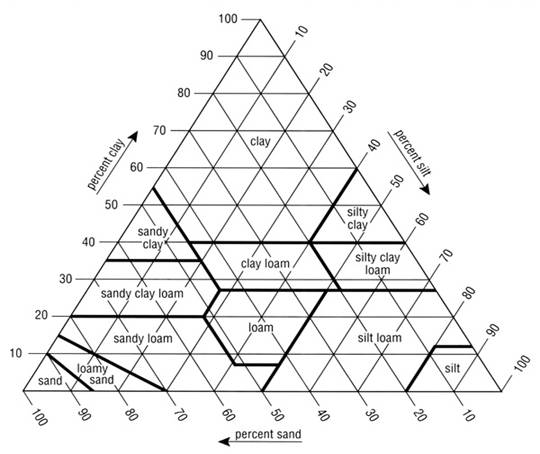Soil Texture
Soil texture has an important role in nutrient management because it influences nutrient retention. For instance, finer textured soils tend to have greater ability to store soil nutrients.
In our discussion on soil mineral composition, we mentioned that the mineral particles of a soil are present in a wide range of size. Recall that the fine earth fraction includes all soil particles that are less than 2 mm. Soil particles within this fraction are further divided into the 3 separate size classes, which includes sand, silt, and clay. The size of sand particles range between 2.0 and 0.05 mm; silt, 0.05 mm and 0.002 mm; and clay, less than 0.002 mm. Notice that clay particles may be over one thousand times smaller than sand particles. This difference in size is largely due to the type of parent material and the degree of weathering. Sand particles are generally primary minerals that have not undergone much weathering. On the other hand, clay particles are secondary minerals that are the products of the weathering of primary minerals. As weathering continues, the soil particles break down and become smaller and smaller.
TEXTURAL TRIANGLE
Soil texture is the relative proportions of sand, silt, or clay in a soil. The soil textural class is a grouping of soils based upon these relative proportions. Soils with the finest texture are called clay soils, while soils with the coarsest texture are called sands. However, a soil that has a relatively even mixture of sand, silt, and clay and exhibits the properties from each separate is called a loam. There are different types of loams, based upon which soil separate is most abundantly present. If the percentages of clay, silt, and sand in a soil are known (primarily through laboratory analysis), you may use the textural triangle to determine the texture class of your soil.

The major textural classes for the soils of Maui are provided in Table . Each of the textural classes listed in Table 3 make up finely textured soils. As you can see, soil surveys show that more than 90% of Maui’s soils are finely textured. This is largely due to the type of parent material of most Hawaii soils, which is basalt. Since basalt is a finely textured rock, it weathers into finely textured soils. The relative amount of clay has great importance in the soil.
Table . Major textural classes of Maui soils
| Textural Class | Percentage of Maui soils that fall within the major textural classes |
| Silty clay | 44% |
| Silty clay loam | 23% |
| Silty loam | 11% |
| Loam | 10% |
| Clay | 5% |
Importance of Clay and Other Particles of Similar Size
Clay particles, as well as other particles of similar size, are important components of a soil. There is a fundamental difference between soils that contain large amounts of sand particles and soils that contain large amounts of very small particles, such as clay. That difference is surface area. The total surface area of a given mass of clay is more than a thousand times the total surface area of sand particles with the same mass. To put this idea into perspective, imagine a single cube with 6 sides. This cube represents a sand particle. Now, imagine that you break this single cube up into 100 smaller cubes, which represent 100 clay particles. These 100 cubes each have 6 sides. Essentially, by breaking up the larger cube, you have exposed many more surfaces. Thus, the total surface area of the smaller cubes will be much greater than the surface area of the single cube.
To explore this concept further, view a brief animation by clicking the following link to North Carolina State University:
This increase in surface area has an important implication in nutrient management because it provides many places for soil particles to retain and supply nutrients (such as calcium, potassium, magnesium, phosphate) and water for plant uptake
Types of Very Small Particles within the Soil
- The most common clay minerals in Maui’s soil are called layered silicate clays, or phyllosilicates. There are different types of layered silicates, such as kaolinite, halloysite, montmorillonite, and vermiculite. The various types of layered silicates differ greatly, as we will discuss later.
For more details about the various layered silicate clay minerals, click on the link below and scroll down to the “Phyllosilicate Room:”
- Amorphous minerals, such as allophane, imogolite, and ferrihydride, may be found in the volcanic soils of Hawaii that developed from volcanic ash. Like silicate clays, these minerals have a very high surface area. As a result, soils with amorphous minerals hold large amounts of water and stored nutrients, depending on the degree of weathering.
- Aluminum and iron oxides are typically found in the highly-weathered soils of the tropics. As clay minerals are intensely weathered, the structure of silicates clays change. Particularly, the silicate clays lose silica. What remains in the soil are aluminum and iron oxides. Gibbsite is an example of an aluminum oxide, which has a grayish, whitish hue. Goethite is an example of an iron oxide, which imparts a reddish color to the soil.
Properties of oxides
- Oxides are fairly stable and resistant to further weathering.
- Oxides can act like a glue and hold other soil particles together.
- Oxides can tie up nutrients, such as phosphorus.
- Oxides have a high anion exchange capacity (AEC).
- Humus is the portion of organic matter that is mostly resistant to decomposition and remains in the soil. Humus is composed of small particles, with tremendous surface area. These particles have a very great capacity to retain and supply nutrients, as well as hold water.


0 Comments:
Post a Comment